Ka-Bar Warthog Knife Review.
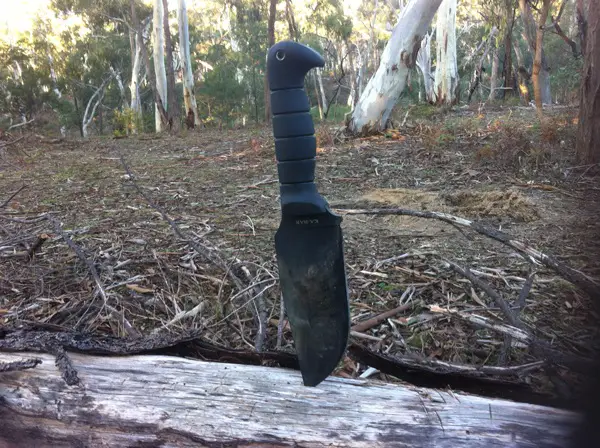
The heavy duty Ka-Bar Warthog knife isn’t pretty, it is chunky and solid, very solid.
I love using my tomahawk, axe and kukri for chopping work. However, I wanted a tool a bit smaller lengthwise, but would still work reasonable enough on smaller to medium chopping tasks. Like de-limbing branches, cutting down saplings for shelter, processing small firewood, etc.
But the knife still had be small enough to use around camp for general bushcraft. Hence, I thought the Warthog knife might be a good compromise between a big chopper.
The wide thick blade would hopefully give the knife blade more weight for chopping. But still small enough to be able to perform for general duties as well. Like cutting cordage, carving, making a fire bow drill, primitive traps, etc.
In this Ka-Bar Warthog Knife review we will test it in the field and see how it performs doing a variety of camping and bushcraft skills with it.
To check out the top bushcraft knives, click on the – Best Bushcraft Knives For Under $100.
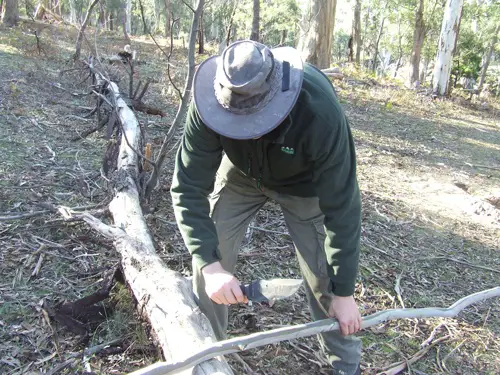
Before we get to the field test and put the Ka-Bar knife through its paces, here are the technical specs of the fixed blade Warthog.
| Weight – | 1.05 lb |
| Blade Type – | Fixed Blade |
| Blade Length – | 6.75 inches |
| Overall length – | 12.25 inches |
| Knife Material – | SK5 |
| Grind – | Flat |
| Handle Material – | TPR |
| Rockwell Hardness – | 52-54 |
| Knife Country of Origin – | Taiwan |
| Sheath Country of Origin – | Taiwan |
| Blade Thickness – | .25 inches |
| Blade Width – | 2.438 inches |
Out of the box.
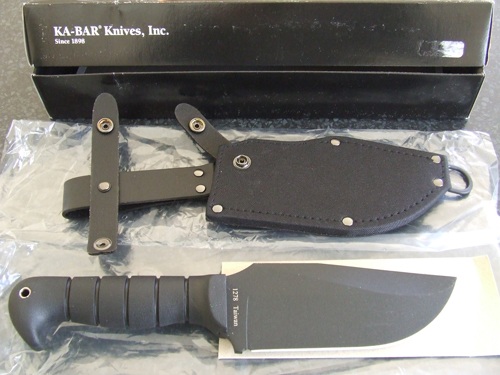
I tested the blade sharpness straight out of the box. The Warthog shaved some hair off my forearm, not scary razor sharp, but enough with a little effort to cut some hair.
Initial impressions – The Ka-Bar Warthog is extremely heavy duty and did I mention the knife isn’t pretty, but very solid! The handle felt nice and balanced well.
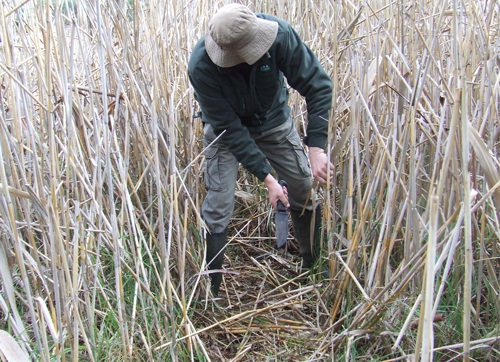
Blade.
The blade is epoxy powder coated, 1085 high carbon steel blade has a HRC rating of 52-54. After some serious batoning the powder coating was wearing a little bit, which was to be expected as the test would be tough on any knife.
The blade material help up well with lots of field work.
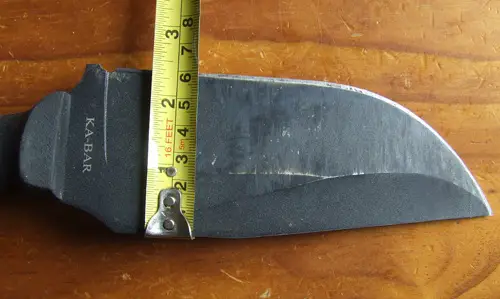
The Warthog handle and hand grips.
The handle was comfortable even after a lot of use. I didn’t notice any hot spots.
While not the prettiest handle compared to wood or antler, the Kraton G handle is similar to rubber, it is durable and holds up well. The Kraton and the grooves in the handle give a non-slip grip and makes it functional. It works.

For most of the test, I used the knife in cold and wet conditions and the handle wasn’t slippery. I even deliberately poured warm water on the handle and the grip still seemed secure.
The butt of the knife handle has a rear slippage guard. This was great when chopping with a more relaxed lose grip, so the knife didn’t pull out of the hand. (The relaxed grip is used, so the hand and arms don’t get tired from tensioning up. The weight of the knife or tool does a lot of the work, not the wrist or arms.)
The kids think the rear guard, bent around looks like a penguin or a bird’s beak. The handle also incorporates a lanyard hole. The whole will fit paracord size cordage.
I didn’t use a lanyard on my tests, but would be a good added safety option if using a loose grip. Or if holding the blade for carving, the lanyard can be slipt over the wrist/forearm to take the majority of weight of the hand.
Weight.
The knife weight on my scales come out at 459 grams – 460 grams. (1.01 lb) With the sheath the Ka-Bar knife weighs in around 579 grams. (1.27 lb) Although my un-scientific scales aren’t calibrated, this is one heavy knife.
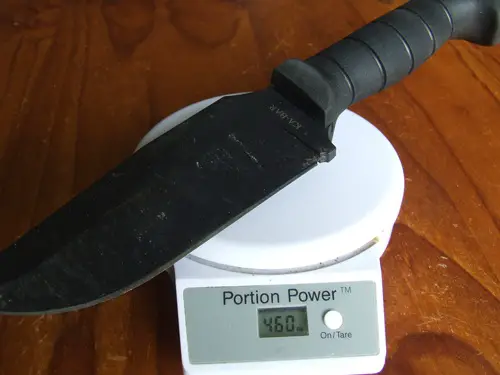
The knife felt very well balanced, although obviously heavy. The balance point was pretty well on the start of the blade.
Knife length.
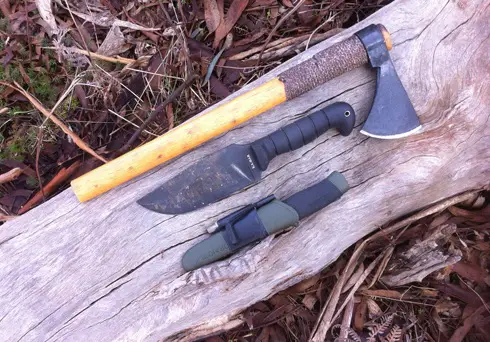
Here is the Warthog knife in the middle, for size comparison with the Coldsteel Tomahawk (Modified length 18”) and Mora Heavy Duty Companion knife.
Sheath.
The sheath is a combination leather and Cordura materials and the sheath holds the knife well.
Initially I thought the studs at the back of the sheath would dig into my hip or legs, but it was fine and comfortable to wear. (Taking in the consideration of the weight of the knife.)
The d ring on the bottom of the sheath for the leg tie is made of a plastic. It looks like it would eventual break. I didn’t use the d-ring and was fine for the test.
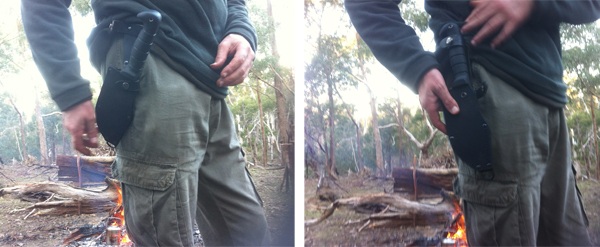
Two straps with press studs on the Warthog sheath keep the knife securely in place.
However, constantly using the knife around camp, getting out of the sheath and un-clipping / unbuttoning two snaps can be a pain. The solution was to just fasten the top snap around the handle and leave the bottom snap undone. (I tried the snaps the other way round and secured the lower clip and left the top handle strap undone. But the knife because of the weight in the sheath would flop about.)
When the knife wasn’t in use as much, such as going for a hike or hunt, I would fasten both snaps for security. After a fair use of taking the knife out and putting it in the sheath while using it, you can start see the sheath wear in places.
Chopping.
The Ka-Bar Warthog screams out to be used for chopping. Using the Warthog knife for de-limbing branches and chopping was, well for lack of a better term, ……. fun. It performed the task effectively for smaller limbs very well.
I also used it several times for chopping down dead small standing trees and it performed great. Obviously not as good as an axe or hatchet, but the weight and design of the knife executed the task very well.
I used a loose grip with a wrist action for the chopping task. It wasn’t over taxing on the wrist and arm. Obviously, over a fair time of chopping with the Warthog, the weight would become tiring.
Batoning, the fixed blade knife torture test.
Batoning is not everyone’s cup of tea, however, I like to test a fixed blade knife out by batoning and see how it handles heavy duty tasks.
Some of the wood I batoned was a fair size diameter and a lot of it hardwood. I must say it was a torture test for the Warthog. (Not your stand on your knife handle while the blade is stuck in a tree trunk kind of knife torture test. Or run the knife over with a truck type test.)
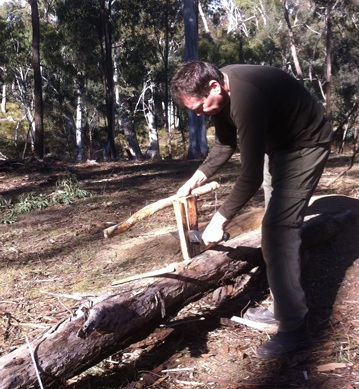
I even tested out the knife by putting the tip in various positions in the wood while batoning. I cringed for the knife, but it passed. The Ka-Bar blade is rock solid.
Flint and steel, or in this case Quartz and knife.
I don’t like using the spine of the knife regularly with flint to get sparks for fire lighting. As it can eats up the back of the knife and most knifes haven’t got the right combination of high carbon steel in them to get good sparks. However I do test the knife to make sure it can be used to obtain a spark for emergencies.
The spine produced sparks with a sharp piece of quartz.
To do this more safely, put the tip of the knife in a stump of wood, or in char tin and hold some char cloth with the point. Strike down with the flint or quartz on the stationary spine of the blade. This is a safer method then holding and waiving a naked blade around.
As well as using the knife for camp duties, feather-sticks, chopping, etc., I also like to see how it goes at helping with fire lighting. In this case a fire bow drill set. Using the Warthog to groove the seating hole for bow drill spindle was good as the wide blade carved a divot hole nicely.
The knife was a little bit harder (As expected.) to use for finer carving like the “V” notch in the side of the hearth board. (Fire or base board.) Choking up the grip on the blade and a touch of patience from me, it was okay. (I normally use the saw blade on a Leatherman multi tool or Swiss army knife initially as it saws a neat groove.)
Sheath modifications.
Simple knife sheath modifications.
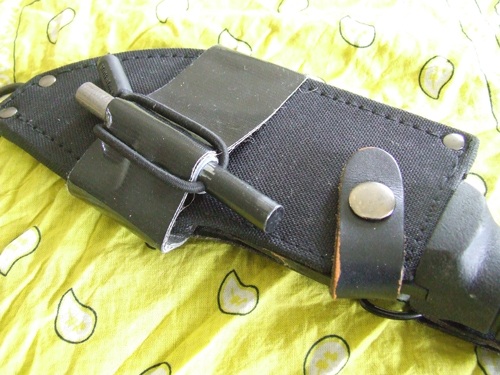
I like having a method for fire lighting on my main knife, and the Warthog knife sheath is ideal for simple modifications as it is wide and flat.
A ferrocerium rod was easy to attach with some tape and a plastic syringe tube.
The plastic tube is cut to length and wrapped with Gorilla cloth tape around the sheath. In this case the ferro rod was a Hultafors Fire Steel (10mm thick.) with a bungee strap and fitted nicely in the plastic tube.
The strap stretches around the end of the ferro rod and the plastic tube holds it securely on the sheath. It looks a bit big and bulky, but the mod goes well with the heavy duty knife.
On the back of the sheath I attached a sail needle and nail.
The sail needle can be used for clothing and equipment repair, or getting out splinters.
The nail is handy for some crude flint knapping or used to help put holes in wood. I made sure the points were covered with two layers of thick tape so they didn’t stick through, especially while carrying the sheath beside my leg.
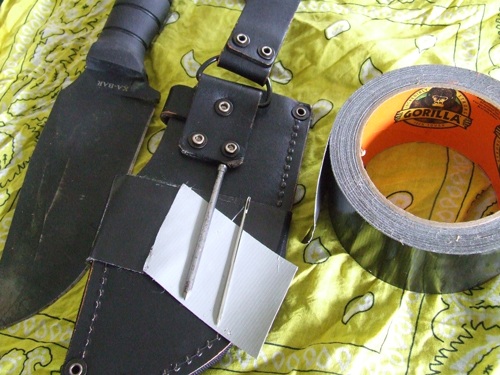
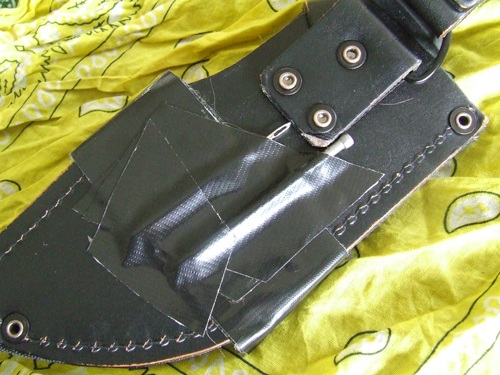
Water purification tablets, like Aquatabs can also be taped onto the back of the knife sheath as the sheath is wide enough.
As a side note, the Gorilla cloth tape can be unwrapped and used as flame extender in a tinder bundle. Or just light with a Bic lighter and use that to get kindling going.
I might also attach some ranger bands (Rubber inner tubes.) on the sheath as well, for the same purpose of fire lighting, especially in wet conditions.
The knife nickname.
I haven’t come up with a nickname yet for the knife. Maybe “The Tank.”, as it is solid and big. Perhaps “THE Warthog” is fitting for now and I will go with that.
More fire lighting with the Ka-Bar.
I also test the spine of the knives combined with a ferrocerium rod (Or ferro rod for short.) to see how well of a spark it produces for fire lighting. The spine of the knife and the ferro rod produced sparks well.
I used a Hultafors Ferrocerium rod for the test.
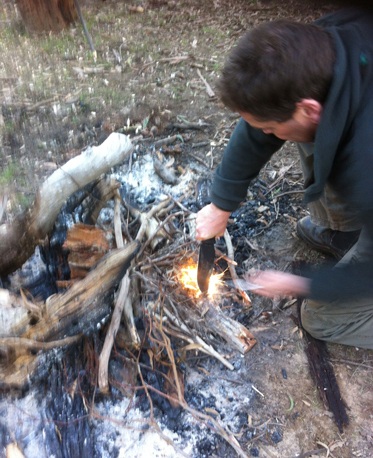
One negative as expected, is the size of the knife for using it for fire lighting.
The wide size of the knife can easily push the tinder away, with the spark not making contact. After a few scrapings on the ferro rod, the weight is an issue.
(I tested out several different type of tinder’s in wet conditions to test them. A better alternative, if using a large or heavy blade or tool is keep the blade stationary and pull back the ferro rod instead.)
I switched to securing the knife into a solid piece of wood and drawing back the ferro rod, while leaving the knife stationary.
The choil at the start of the blade also works well for fire lighting. Although having hands moving nearer the blade is not textbook as safe.
The spine of the blade, both close to the tip/point and the spine closer to the handle work nearly as good as each other. With the spine closer to the tip getting a slightly more sparks as the spine edge is a bit thinner and sharper so to speak.
A dedicated ferro rod scraper being lighter weight and smaller may be a better option, however the Warthog’s knife spine works reasonable good for fire lighting.
Drawbacks of the knife.
Obviously using the knife for finer detailed tasks isn’t ideal with the wide blade. However if you can look past it isn’t designed for that, it is a solid workhorse knife and designed for using it for heavy duty tasks. (Whilst still smaller than the hatchet, machete type tool.)
For me personally the knife doesn’t seem to have too many negatives. You could say the width of the blade and weight could be a negative, but for me I wanted a durable knife to do a lot of chopping and some batoning. I guess you can’t really buy a truck and then complain that it doesn’t go as fast as a Ferrari or park like a small VW.
It is a compromise, like most bushcraft tools.
The sheath was possible the biggest drawback.
The sheath secures the knife well, but the materials showed signs of wear and tear quicker than I would have liked in this knife review. One example was wear around the dangler belt loop where the handle makes contact it has worn off the finish.
The wish list.
It would have been nice to have a metal pommel in the handle for hammering. But this would undoubtedly make it heavier and affect the balance, especially for chopping tasks, etc.
The sheath would have been nice to have a pouch for a small sharpening stone or ferro rod holder. But this puts the price up on manufacturing the sheath.
A bow drill divot on the knife handle would be nice for friction fire. Obviously the bearing block hole would have to be on the handle in a place where the knife is sheathed. Because of the weight and balance of the knife, I don’t think it would be practical. But hey, it is a wish list.
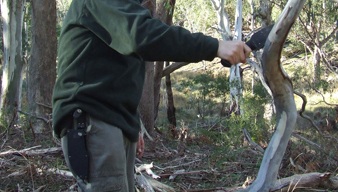
Summary of the Ka-Bar Warthog knife review.
The fixed blade Warthog is durable and performs well.
I have used it deliberately using on tasks that I normally use my tomahawk, kukri or machete for, as well as finer tasks. Sure and axe is superior for chopping, however if you look at it at as a tool, they all have their own unique positives and negatives.
The knife won’t do it all, because of the weight and size of it, or suit all terrains, but it has some great values that make it a good bushcraft tool for me. In the scenario of, “If you only had one knife to take in a long term wilderness situation.” I would say that is probably not realistic and try and take an axe, bow saw, hatchet, multiple size knives, etc., etc. But if really pressed for the one tool to take though, the Ka-Bar Warthog knife would be on my short list to consider.
It is ugly and heavy, perhaps a jack of all trades and a master of none, but gee it is a good knife that I would be happy to take into the woods.
For other good bushcraft and survival knives click on – Best Bushcraft Knives For Under $100.
